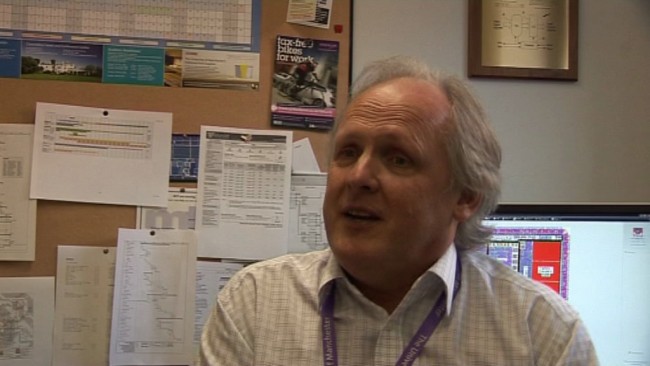Steve Furber
|
Steve Furber Professor Stephen Byram Furber CBE, FRS, FREng (born 1953 in Manchester, England) is the ICL Professor of Computer Engineering at the School of Computer Science at the University of Manchester but is probably best known for his work at Acorn where he was one of the designers of the BBC Micro and the ARM 32-bit RISC microprocessor. Furber was educated at Manchester Grammar School and represented the UK in the International Mathematical Olympiad in Hungary in 1970. He went up to Cambridge and received a BA in mathematics in 1974. In 1978, he was appointed the Rolls-Royce Research Fellow in Aerodynamics at Emmanuel College, Cambridge and was awarded a PhD in 1980. From 1980 to 1990, Furber worked at Acorn Computers Ltd where he was a Hardware Designer and then Design Manager. He was a principal designer of the BBC Micro and the ARM microprocessor. In August 1990 he moved to the Victoria University of Manchester to become the ICL Professor of Computer Engineering and established the Amulet research group. In February 1997, Furber was elected a Fellow of the British Computer Society. In 1998, he became a member of the European Working Group on Asynchronous Circuit Design (ACiD-WG). In 2002, he was elected a Fellow of the Royal Society and was Specialist Adviser to the House of Lords Science and Technology Select Committee inquiry into microprocessor technology. In 2003, he was a member of the EPSRC research cluster in biologically-inspired novel computation. On 16 September 2004, he gave a speech on Hardware Implementations of Large-scale Neural Networks as part of the initiation activities of the Alan Turing Institute. He was elected a Fellow of the IEEE in 2005. In September 2007 he was awarded the prestigious IET Faraday Medal. Professor Furber's latest project is known as Spinnaker, also nicknamed the 'brain box', to be constructed at the University of Manchester. This is an attempt to build a new kind of computer that directly mimics the workings of the human brain. Spinnaker is essentially an artificial neural network realised in hardware, a massively parallel processing system eventually designed to incorporate a million ARM processors. The finished Spinnaker will model 1% of the human brain's capability, or around 1 billion neurons. Furber is a Fellow of the Royal Academy of Engineering, of the Royal Society, the IEEE and the Institution of Engineering and Technology, and is a Chartered Engineer. He is on the Advisory Board of Theseus Logic, Inc. Furber's research interests include asynchronous systems, ultra-low-power processors for sensor networks, on-chip interconnect and GALS (Globally Asynchronous Locally Synchronous), and neural systems engineering. He was appointed Commander of the Order of the British Empire (CBE) in the 2008 New Year Honours. Steve Furber's book "ARM System-on-Chip Architecture" describes the design and operation of the ARM processor, a 32-bit RISC microprocessor from ARM Ltd. Full details are given of the ARM and Thumb instructions sets and the memory management architecture. There is illustrated discussion of how the ARM instruction set supports high-level language constructs. ARM products are described, including the ARM7TDMI, ARM9TDMI and ARM10TDMI cores, the 710T, 720T, 740T, 920T, 940T, 1020E and StrongARM and some information on the AMULET asynchronous ARM cores. Embedded system design using the ARM is covered, including the debug methodology, hardware system design principles and software issues. Examples include the ARM71OO chip used in the Psion 5, the ARM7500 NC chip, the VLSI Ruby II, VIP and OneC GSM chips, the Ericsson-VLSI Bluetooth chip and the SA-1100 high-performance PDA chip. Hermann Hauser of Acorn said that "Steve is one of the brightest guys I've ever worked with - brilliant and when we decided to do a microprocessor on our own I made two great decisions - I gave them two things which National, Intel and Motorola had never given their design teams: the first was no money; the second was no people. The only way they could do it was to keep it really simple." Furber defined the architecture while Sophie Wilson developed the instruction set. "While IBM spent months simulating their instruction sets on large mainframes, Sophie did it all in her brain," remembers Hauser. It was the birth of a microprocessor phenomenon - a chip which did the same amount of work as other 32-bit microprocessors but used one tenth of their transistors - and consequently one tenth of their electricity. "At 1pm on April 26th 1985, the first ARM microprocessors arrived back from the manufacturer - VLSI Technology, Inc", recalls Furber, "they were put straight into the development system which was fired up with a tweak or two and, at 3pm, the screen displayed is believed to have said: 'Hello World, I am ARM'." We are very proud that Steve has very kindly donated his Psion Series 5 to The Centre For Computing History Books Written by Steve Furber :Magazine Articles Mentioning Steve Furber :Historical Timeline for Steve Furber :
|
|











